The school environment represents one of the only places that children in the UK have in common. The environment may present different challenges for students but it’s a social and educational environment where they can get the most out of fitness.
The pressure on schools to produce results on the academic side often overshadows those for physical activity. To raise physical activity to the levels necessary to meet guidelines, creativity on school grounds should be a number one priority. This level of creativity needs purposeful support from the activities sector.
What young people want
Young people need and want variety in their physical activity sessions. Keeping them active means we must encourage activity from the youngest possible age, especially where first-time parents are concerned. Promoting opportunities for play and socialisation can encourage life-long activity from toddlers to adults.
When young people are asked about their school PE programs, they largely see their exercise programmes as not having enough variety. Many schools out of sheer lack of time will stick to traditional sports such as netball, football, rugby and athletics.
With very little time carved out in the curriculum for sport, there is little time for pupils to find a sport they like. Traditional sports are often pushed out for some of the less conventional sports such as skateboarding and BMXing. They raise the heart rate and offer them some independent movement but are more likely to be out of the reach of most schools.
Don’t get caught up by guidelines
Whilst it’s important not to ignore them, guidelines for activity strongly mandate moderate to vigorous physical activity (MVPA). Cycling to school, for example, wouldn’t be included. By focussing on MVPA, you miss the benefits associated with all types of activity, whether light or vigorous.
Active travel is one of the best ways to consistently encourage lifelong fitness. It is associated with healthier bodies and better fitness in children. By encouraging these types of travel, anything from scooting to cycling can help improve young people’s activity levels. Extra exertion from more traditional sports can put some young people off.
Evidence shows that schools cannot be replaced, especially for those children who are most deprived. It’s not about quantifying activity but looking for quality and variety that fits different schools and children with different needs.


